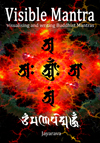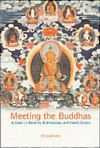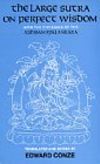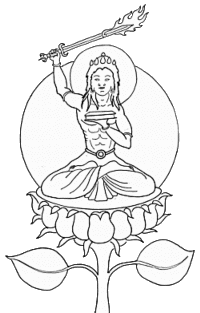

maṃ ju śrī

maṃ ju gho ṣa
The names Mañjughoṣa and Mañjuśrī are synonyms for the same figure, although there are sometimes slight iconographic differences between them in Buddhist art. In Sanskrit mañju means: "beautiful, lovely, charming, pleasent, sweet"; while ghoṣa means "voice", while śrī has a range of meanings taking in "light, lustre, radiance; properity, welfare, good fortune, success, auspciousness; high rank, royalty". So Mañjughoṣa can mean Beautiful Speech, and Mañjuśrī might be translated as Lovely Prince, or Beautiful Radiance, etc.
The emblems of both figures are the flaming sword in the right hand, and the book in the left. Sometimes these are perched upon lotuses which are held in the relevant hand. Sometimes the book is held to the heart and sometimes out to the side. The book is the Aṣṭasāhasrikā Prajñāpāramita Sutra - the Perfection of Wisdom in 8000 lines.
He is sometimes known as Arapacana Mañjuśrī after his mantra (in the Mañjuśrīnāmasaṃgitī for instance) which is also known as the Arapacana Mantra - see below. Another name he goes by is Vagiśvara or Lord of Speech.
Seed Syllable
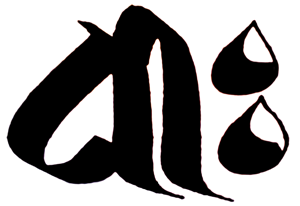 Siddhaṃ |
Mañjuśrī 's seed syllable is dhīḥ, the seed syllable of perfect wisdom which he shares with Prajñāpāramita.
For more information on dhīḥ see also my essay The Seed Syllable of Perfect Wisdom. |
 Tibetan - Uchen |
mantra
Siddhaṃ

Tibetan - Uchen

Lantsa

Devanāgarī

Transliteration
oṃ a ra pa ca na dhīḥ
Tibetan pronunication is slightly different and so the Tibetan characters read:
oṃ a ra pa tsa na dhīḥ
Notes on the Mañjuśrī-Mañjughoṣa/Arapacana Mantra
The middle part of the mantra consists of the first five syllables of what is most likely the Gāndhārī alphabet - it is clearly not Sanskrit which has quite a different order. I have written a short essay on the Arapacana alphabet on my blog. I'm unsure about the oṃ and dhīḥ, the first of which especially, seems to frame it as part of the general Mahayana Dhāraṇī cult. dhīḥ is strongly associated with the Prajñāpāramita tradition, but I haven't explored the nature of the connection yet. One source of the alphabet is the Pañcaviṃśatisāhasrikā Prajñāpāramita Sutra, The Perfection of Wisdom in 25,000 lines, which Conze translates in his book The Large Sutra on Perfect Wisdom which sets out the following meanings for the first syllables:
| A | is a door to the insight that all dharmas are unproduced from the very beginning (ādya-anutpannatvād); |
| RA | is a door to the insight that all dharmas are without dirt (rajas); |
| PA | is a door to the insight that all dharmas have been expounded in the ultimate sense (paramārtha); |
| CA | is a door to the insight that the decrease (cyavana) or rebirth of any dharma cannot be apprehended, because all dharmas do not decrease, nor are they reborn; |
| NA | is a door to the insight that the names [i.e. nāma] of all dharmas have vanished; the essential nature behind names cannot be gained or lost. |
Each letter of this mystical alphabet then is associated with some point of the Dharma, and all together are referred to as the syllable-doors (to the Dharma). The 'power' of these syllables is somewhat cryptically explained, but I think the point is that all of the reflections are pointing towards the nature of śunyata. (See The Wisdom Alphabet for more detail).
The first sentence in Sanskrit - akāro mukhaṃ sarvadharmāṇāṃ ādyanutpannavāt - went on to become a mantra in its own right in the Hevajra Tantra for instance.
Vagiśvara
Mañjuśrī is sometimes known by an epithet that is also borne by Śiva, and by Indra before him. Vak is speech in Sanskrit. In Vedic texts Vāc is treated as a Goddess in her own right. Vagiśvara combines vāc and īśvara and means Lord of Speech. Since it is Vāc or speech that forms the basis of mantra, to be the Lord of Speech is to be Lord of Mantra.
Mantra
Siddham

Transliteration
oṃ va gi śva ra muḥ
oṃ vagiśvara muḥ
Tibetan
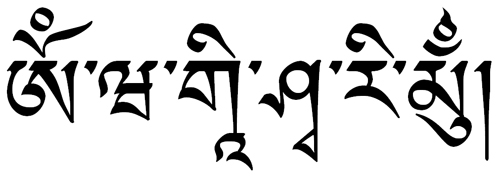
Transliteration
oṃ va gī śva ri muṃ
oṃ vagīśvari muṃ
The Tibetan version often has īśvari rather than īśvara, but this is incorrect.
Mañjuśrī Hṛdaya Mantra

"Possessing six syllables, by nature releasing one
from the six unfortunate rebirths,
equal to incomparable, inconceivably great power.
Releasing one from the binding fetters of existence,
the tumultuous ocean of every form of existence,
the pain of the three sufferings.
Unbearable for all demons,
an anointment for the entire world.
Invincible against all demons,
completely purifying the path of becoming.
Establishing the teachings of the buddhas,
hindering all obstacles,
applauded by all buddhas,
accomplishing every kind of good fortune.
Superior among all mantras
in the teaching of Mañjughoṣa.
Which mantra is that? It is oṃ vākyeda namaḥ"
These verses are taken from chapter twenty-nine of the Mañjuśrīmūlakalpa as translated by Glenn Wallis in “om vakya da namah: Manjusri’s mantra and its Use in Historical Perspective,” in As Long As Space Endures: Essays on the Kalachakra Tantra in Honor of H.H. the Dalai Lama, (Ithaca: Snow Lion Publications, forthcoming). Available on Glenn's Website.
This mantra is also related to Mañjuśrī's role as Lord of Speech (vāc)
There is an online version of the Sanskrit text of the Mañjuśrīmūlakalpa as part of the Gretil Archive.
More information
visiblemantra.org
- I have gathered up information on the meditation practice on the the Wisdom Alphabet on a new page
- See also the Arapacana Alphabet page.
Jayarava Rave
- The Buddhist Wisdom Alphabet
- The Mystical Arapacana Alphabet
- Meditating on Arapacana
- On the bīja dhīḥ see my essay The Seed Syllable of Perfect Wisdom.
External Sources
- Dharmacari Anandajyoti. Manjusri : origins, role and significance. Part 1 & 2 and Part 3 Western Buddhist Review. no. 2 Aug 1997 & no. 1 Dec 1994
- On the theory that the arapacana alphabet is Gāndhārī see: Richard Salomon. New Evidence for a Gāndhārī Origin of the Arapacana Syllabary. Journal of the American Oriental Society, Vol. 110, No. 2 (Apr - Jun, 1990), pp. 255-273.
- There are a couple of articles on Mañjuśrī on Glenn Wallis's Website.

